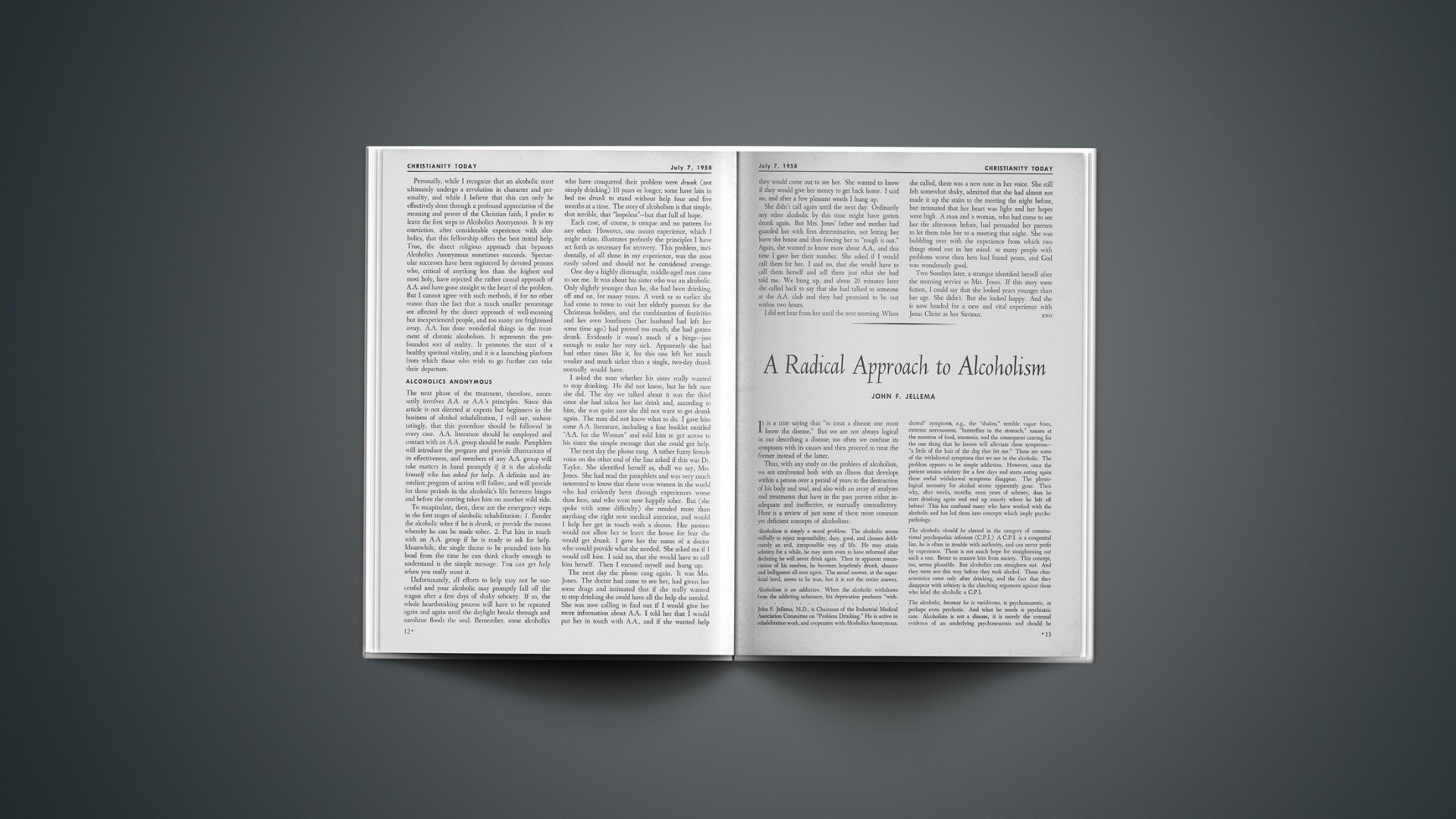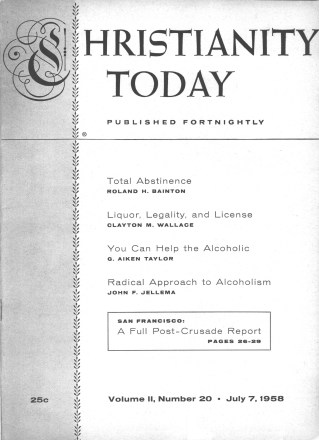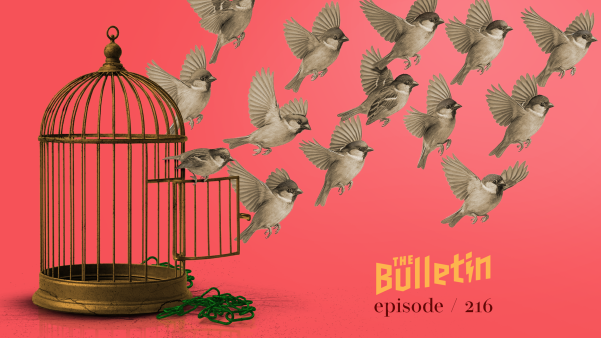It is a trite saying that “to treat a disease one must know the disease.” But we are not always logical in our describing a disease; too often we confuse its symptoms with its causes and then proceed to treat the former instead of the latter.
Thus, with any study on the problem of alcoholism, we are confronted both with an illness that develops within a person over a period of years to the destruction of his body and soul, and also with an array of analyses and treatments that have in the past proven either inadequate and ineffective, or mutually contradictory. Here is a review of just some of these more common yet deficient concepts of alcoholism:
Alcoholism is simply a moral problem. The alcoholic seems wilfully to reject responsibility, duty, good, and chooses deliberately an evil, irresponsible way of life. He may attain sobriety for a while, he may seem even to have reformed after declaring he will never drink again. Then in apparent renunciation of his resolves, he becomes hopelessly drunk, abusive and belligerent all over again. The moral answer, at the superficial level, seems to be true, but it is not the entire answer.
Alcoholism is an addiction. When the alcoholic withdraws from the addicting substance, his deprivation produces “withdrawal” symptoms, e.g., the “shakes,” terrible vague fears, extreme nervousness, “butterflies in the stomach,” nausea at the mention of food, insomnia, and the consequent craving for the one thing that he knows will alleviate these symptoms—“a little of the hair of the dog that bit me.” These are some of the withdrawal symptoms that we see in the alcoholic. The problem appears to be simple addiction. However, once the patient attains sobriety for a few days and starts eating again these awful withdrawal symptoms disappear. The physiological necessity for alcohol seems apparently gone. Then why, after weeks, months, even years of sobriety, does he start drinking again and end up exactly where he left off before? This has confused many who have worked with the alcoholic and has led them into concepts which imply psychopathology.
The alcoholic should be classed in the category of constitutional psychopathic inferiors (C.P.I.) A C.P.I. is a congenital liar, he is often in trouble with authority, and can never profit by experience. There is not much hope for straightening out such a one. Better to remove him from society. This concept, too, seems plausible. But alcoholics can straighten out. And they were not this way before they took alcohol. These characteristics came only after drinking, and the fact that they disappear with sobriety is the clinching argument against those who label the alcoholic a C.P.I.
The alcoholic, because he is recidivous, is psychoneurotic, or perhaps even psychotic. And what he needs is psychiatric care. Alcoholism is not a disease, it is merely the external evidence of an underlying psychoneurosis and should be treated by a psychiatrist. However, if this be the difference between a moderate drinker and an alcoholic, then curing him of his psychoneurosis would make it possible for him to return to moderate, or at least social drinking. But nowhere in literature has anyone claimed to have returned the alcoholic to social drinking. On the contrary, even after 10 years’ sobriety, a few drinks within a few days or weeks will bring him back to where he left off. This solution is apparently true, but it assumes that his defection is deliberate.
The alcoholic’s problem is physiological. This, of course, is also the judgment of the materialist (mind and body both can be explained by chemistry or physiology). And because only two per cent of those who drink actually become alcoholics, the defect then is probably genetic and predisposes or sensitizes him to alcohol. Again, this may seem a plausible opinion, particularly because so many of his symptoms are due to vitamin and other deficiencies. But it confuses the effects with the cause.
The alcoholic is socially maladjusted. He has family troubles, financial worries, maybe he has lost his job. But almost invariably the socially maladjusted individual, as a result of alcoholism, might use any of these as an occasion, not a cause, for going on a drunk.
The alcoholic is, in the last analysis, a complex problem, and what we need for him is the “team” approach. The physician, the psychologist, the social worker, the psychiatric social worker, the nutritionist, the public health nurse, all composing a clinic, can examine him and record their findings. But because each one thus approaches the patient from his own angle and with his own notions as to what the nature of the disease is, the results can be and often are quite confusing. What is the analogy here?
The Problem As Person
None of the above concepts get at the alcoholic’s fundamental problem. We should know first of all what sort of person he is and how he became an alcoholic. I repeat, only two per cent of those who drink become alcoholics. Can there be a common denominator among these two per cent?
I believe these two per cent may be characterized roughly as follows:
1. The alcoholic is basically the good-hearted, softhearted, tender-hearted fellow who would give you the shirt off his back. (This does not mean he cannot be selfish.)
2. He is of better than average intelligence. He is usually the better skilled workman, tradesman, salesman, executive or professional man.
3. He has, deep within him, feelings of inferiority and inadequacy; and the oftener he fails in his resolves to quit drinking, the less confidence he has in himself.
4. He is a sensitive person, easily hurt and stores these hurts and resentments. Usually after he has been on a “bender” he wonders, “Does he know? Does she?”
5. He is emotionally immature, and tends to solve his problems according to his emotions rather than his intelligence. He is impatient and wants the solution now, and the oftener he sidesteps these problems by getting drunk, the greater his problems become and the less able he is to face reality.
When the alcoholic comes to one for help, he has usually been drinking for some five to fifteen years or more and has been out of control for at least two years. He cannot tell you just when he became an alcoholic; as often as not he fails to realize he is one. He has gone from social drinking to the phase of contentment where he has developed a tolerance to alcohol that requires larger doses for relaxation. He does experience some unpleasant effects owing to increased intake, e.g., hangover or headache. From here he enters a phase of slight concern where his increased tolerance necessitates even larger doses of alcohol, and where he experiences probably his first “blackout.” Beyond this is the point of no return for him to normal drinking. He has more “blackouts” and begins to experience the “shakes,” “morning drink” and “craving.” In this phase, he is sensitive about his drinking, minimizes it to others, and tries sneaking an extra drink or two. He may even try cutting down with no success.
Following that period he enters the phase of resistance. Here he rejects any reformation of life whatever by rationalizing, lying, making alibis and resenting those who would help him effect a change. Other disease symptoms may begin to appear, such as peripheral neuritis or alcoholic gastritis; and his dependence on alcohol increases, while “desirable” effects of alcohol decrease.
From this point he is led to a phase of acceptance, either through fear of diseased reaction and associated problems, or through the interest of someone who, by instruction and sympathy, will help him gently to accept a new way of life. He may now be experiencing hallucinations of sight or sound, or dread delirium tremens, and he himself notices dulling of his mental faculties.
If, in this phase he seeks help and does not find it because of a lack of understanding, sympathy or patience on the part of those who would help him, he descends to the final phase of helplessness, hopelessness and despair. And it is at this point that he gives up struggling and either commits suicide, or dies in one of the terminal diseases of alcoholism such as cirrhosis, Korsakoff’s syndrome or pancreatitis. (This division of the progress of the alcoholic into phases is based on Jellinek’s “Profile of the Alcoholic” as modified by R. G. Bell of the Bell Clinic, Willowdale, Ontario.)
Twofold Addiction
On the basis of 12 years’ work with alcoholics in the various phases of their problem, it seems to me that the alcoholic has really a twofold addiction: first, a physiological addiction to alcohol characterized by withdrawal symptoms, and second, a long-range addiction to escape. The key to understanding the alcoholic is this twofold addiction coupled with his characteristic personality as outlined above. His entire situation is a vicious cycle in which his feelings of inferiority are increased as his problems are intensified. It finally becomes impossible for him to face reality (his addiction to escape), and this in turn accounts for the fact that even after a period of sobriety, if confronted again with his emotional problems, he will give way. The fact that he still has feelings of remorse and dissatisfaction with himself, however, suggests the key to the solving of his problem. And his problem essentially is a spiritual one.
This is what accounts for the success of Alcoholics Anonymous. Its “12 steps” constitute essentially a spiritual approach to the problem. If we had to do away with all treatments, save one, offered to an alcoholic, that which we would keep would be the one of A.A.
There are, of course, adjuncts to A.A. medical treatment for the physiological addiction is one, and this should be done by some physician who is cognizant of the patient’s full need, and at a time when the patient is remorseful, not the day after. Antabuse, which makes it impossible for a person to drink while he is taking it, and for six to fourteen days after, if he should discontinue it, is of tremendous help especially during the year or so that he is growing in the program of A.A. and only if, by the patient’s consent, he has a collaborator and both are receiving instructions from a physician.
But the basic approach that A.A. makes to the total (spiritual) rehabilitation of an alcoholic is possible only if he recognizes that the alcoholic must know and be willing to admit that he is an alcoholic (the 20 questions help to separate the alcoholics from the social drinkers), that he can never be a moderate drinker again, that as much as his relatives, friends or minister would like to do this for him, only he can resolve his own problem, and that he cannot do this by himself but needs help. Once he is convinced of the truth of these four things, he is ready for the 12 steps of A.A.
Briefly, these 12 steps may be paraphrased: “I am powerless over alcohol … There is a Power greater than myself, God … [I] humbly seek to know his will … [and] bring help to others …” Has this not a familiar ring—the conviction of sin, of helplessness, of turning to God, and then a life of gratitude? A.A. knows that “What I keep unto myself, I lose; what I give away I keep.” “Daily prayer and daily returning of thanks”; “You can only live today”—(cf. 20 Questions, self-scoring, under the title “Are You an Alcoholic?” and also “The Twelve Steps of A.A.”).
As we thus recognize alcoholism to be the spiritual problem that it is, we can see the implications that it has for the minister, and also the physician and social worker, or anyone else. He who would help the alcoholic must have sympathy, empathy, patience and perseverance. Unless he loves this helpless soul and has compassion for him, he should not even start. Once having started, of course, he must never give him up. Only the permanent sobriety or death of the patient can release one’s obligation to him.
The approach to the alcoholic is a personal one, well expressed at a meeting of the Norwegian Medical Society in 1956. After Dr. Wildhagen had given an account of his experience working with 487 patients in close cooperation with A. A., another speaker “… compared Wildhagen’s methods with those of the salmon fisher who hangs onto his prey by the hour till he has landed him safely. Wrestling for a whole night with his man, Wildhagen would at last argue him into a clear perception of his ailments and desertion of his defensive mechanism, achieving in one night what might otherwise have required weeks or months.”
Anyone who has worked with the alcoholic in all the phases of his problem, seen him when he is unconcerned or going through the terrible withdrawal symptoms, held a basin for him when he is sick, heard his sobs of remorse and despair, been with him when he finally surrenders to a higher Power and from there grows into sobriety and confidence, clear thinking and good judgment, a better man, husband, father, worker and citizen—anyone who has seen this happen to what appears a hopeless bum knows that he stands in the presence of the miraculous.
John F. Jellema, M.D., is Chairman of the Industrial Medical Association Committee on “Problem Drinking.” He is active in rehabilitation work, and cooperates with Alcoholics Anonymous.










